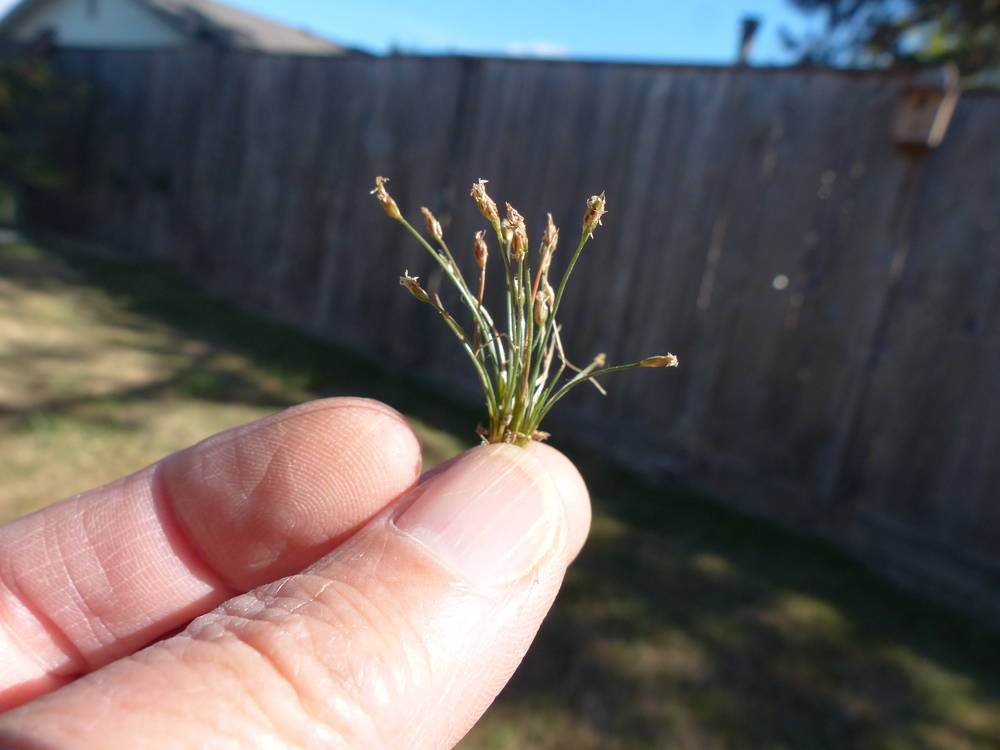Eleocharis engelmannii
Eleocharis bella
Engelmann's spikerush
delicate spikerush, pretty spikerush
terete, 2–40 cm × 0.5–1.5(2) mm.
often ascending or spreading, 4-angled or terete 1–7 cm × 0.2–0.3 mm.
lanceoloid to subcylindric, 5–10(20) × 2–3(4) mm;
proximal scale empty, encircling approximately 67% of culm; floral scales 25–100(200), 8–12 per mm of rachilla, 2(2.5) × 1–1.3 mm;
apex narrowly rounded to subacute.
ovoid, 1.5–4 × 0.8–2 mm; floral scales 4–15, 8 per mm of rachilla, 1–1.5 × 0.5–0.7 mm;
midrib obscure to somewhat keeled;
apex narrowly acute to acuminate, slightly recurved.
perianth bristles present or often absent; (0)5–8; about as long as the achenes;
anthers 0.3–0.7(1) mm;
stigmas 2–3.
perianth bristles absent;
anthers 0.3–0.5 mm;
stigmas 3.
biconvex or to 33% greatly compressed trigonous, 0.9–1.1(1.5) × 0.7– 1.1 mm.
with about 6–10 rather prominent angles and longitudinal ridges, broadly ovoid; less than 2 times longer than wide; (0.55)0.65–0.75 × 0.3–0.4 mm; fine horizontal ridges distinct, 20–30.
persistent, apex of distal leaf sheath obtuse to acute, with tooth to 0.3 mm.
often splitting;
apex acute.
depressed, subdeltoid, 0.1–0.3(0.4) × 0.6–0.9(1) mm, 10–40% as high as wide, 25% or less as high as achene, 90% as wide as achene.
mostly appressed; pyramidal, often depressed, 0.1–0.2 × 0.1–0.25 mm.
Eleocharis engelmannii
Eleocharis bella
Freshwater shores exposed by seasonal low water levels, marshes, disturbed wetlands. 50–500 m. WV. CA, ID, WA; north to British Columbia, east to MA, southeast to AL. Native.
Eleocharis engelmannii is similar to E. ovata and the much more common E. obtusa but has markedly shorter tubercles and usually more cylindric spikes.
Exposed lake margins and streamsides, wet meadows. 0–2100 m. BR, BW, ECas, Owy, Sisk, WV. CA, ID, NV, WA; northeast to MT, southeast to NM, south to Mexico. Native.
Eleocharis bella has sometimes been considered a variety of E. acicularis, which is a rhizomatous perennial with larger floral scales, anthers, and achenes. Hybrids between the two are unknown.
Barbara Wilson, Richard Brainerd, Nick Otting
Barbara Wilson, Richard Brainerd, Nick Otting
- Local floras:
BC,
CA,
OR,
WA
- Local Web sites:
CalFlora,
CalPhotos,
Flora NW,
PNW Herbaria
WildflowerSearch
iNaturalist (observations)
USDA Plants Database
- LBJ Wildflower Center
- SEINet
- Plants of the World Online
- Encyclopedia of Life
- Wikipedia
- Google Image Search
- Local floras:
CA,
OR,
WA
- Local Web sites:
CalFlora,
CalPhotos,
Flora NW,
PNW Herbaria
WildflowerSearch
iNaturalist (observations)
USDA Plants Database
- LBJ Wildflower Center
- SEINet
- Plants of the World Online
- Encyclopedia of Life
- Wikipedia
- Google Image Search




